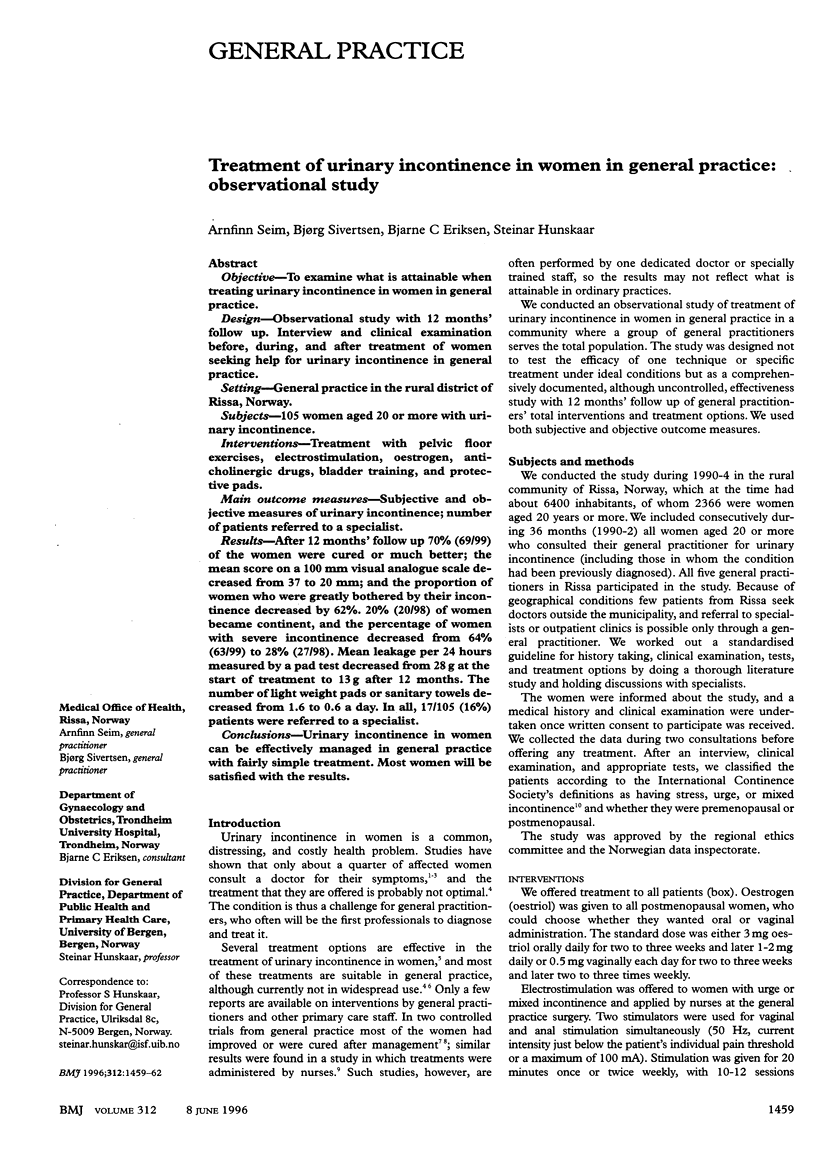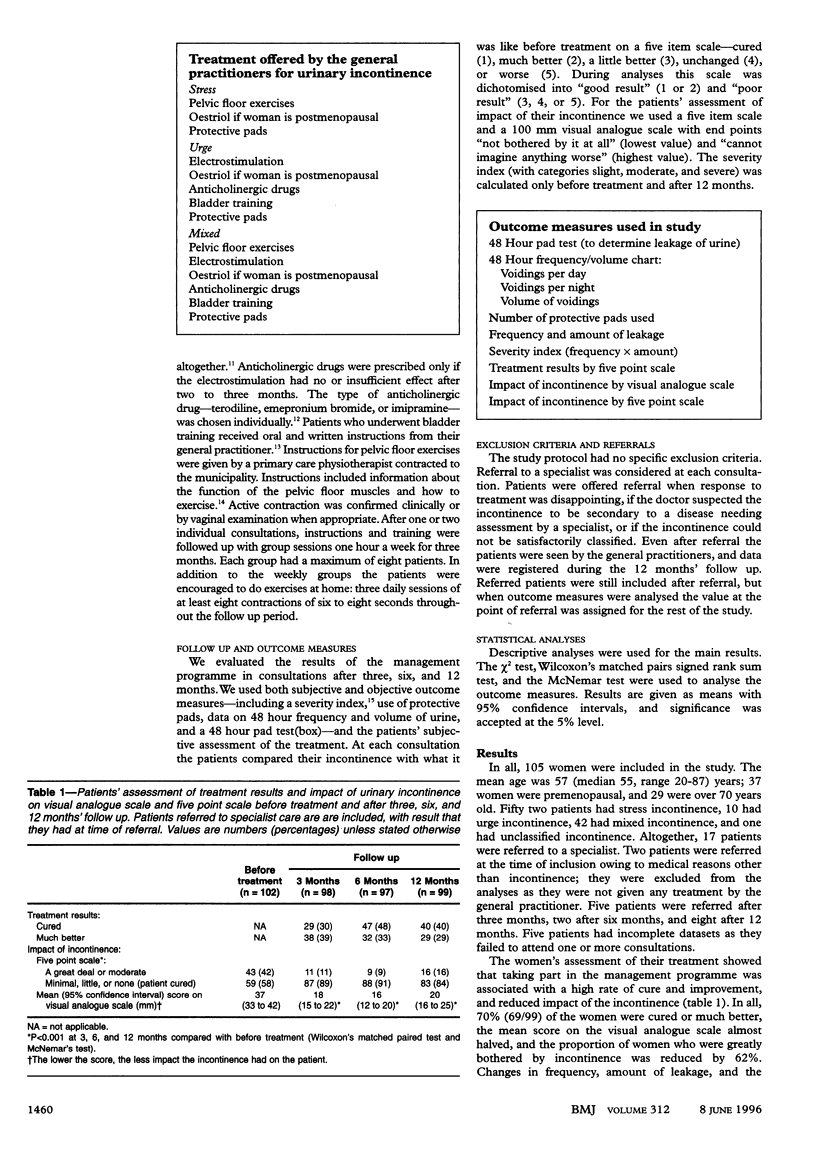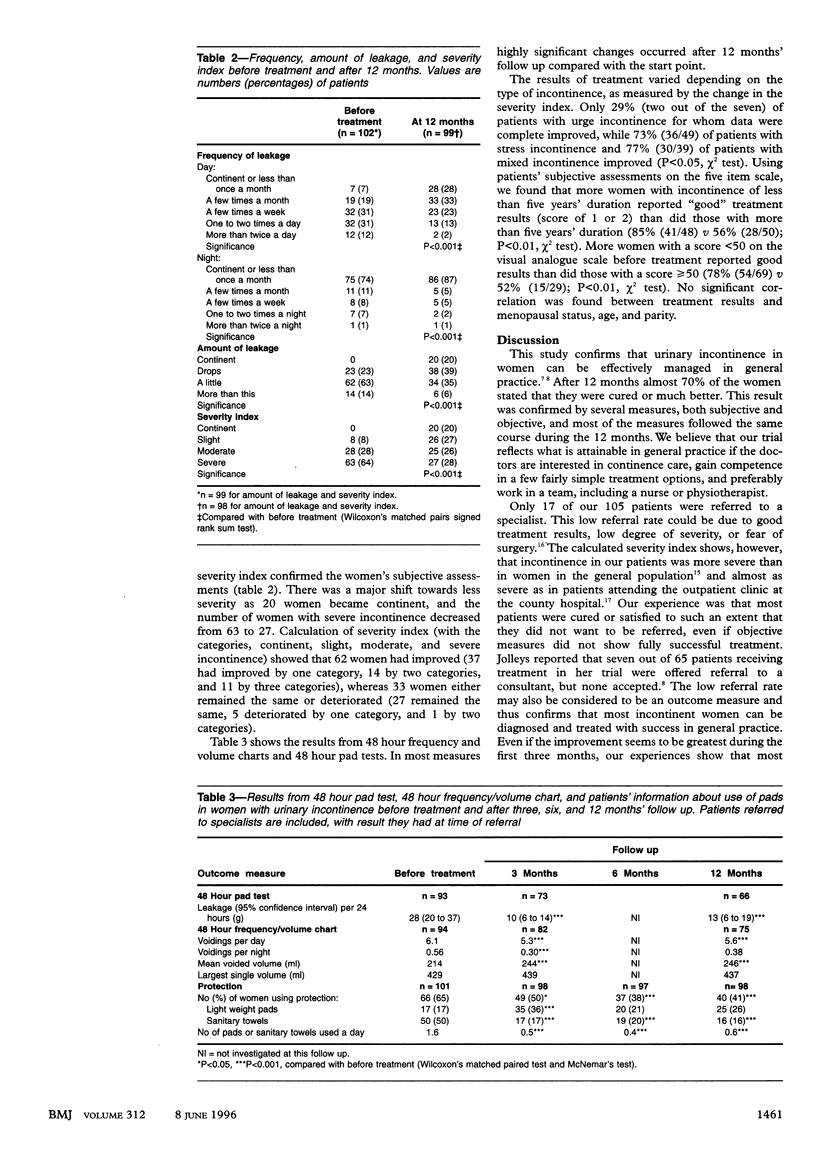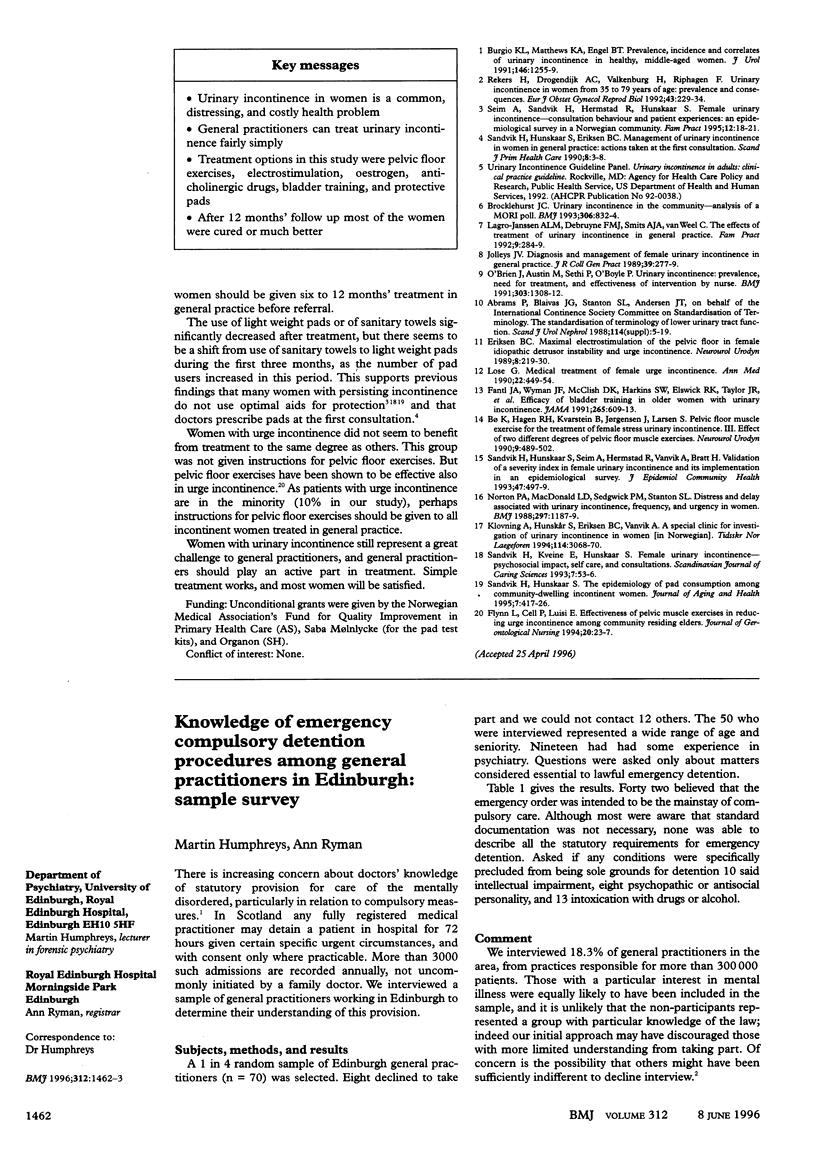Abstract
OBJECTIVE--To examine what is attainable when treating urinary incontinence in women in general practice. DESIGN--Observational study with 12 months' follow up. Interview and clinical examination before, during, and after treatment of women seeking help for urinary incontinence in general practice. SETTING--General practice in the rural district of Rissa, Norway. SUBJECTS--105 women aged 20 or more with urinary incontinence. INTERVENTIONS--Treatment with pelvic floor exercises, electrostimulation, oestrogen, anticholinergic drugs, bladder training, and protective pads. MAIN OUTCOME MEASURES--Subjective and objective measures of urinary incontinence; number of patients referred to a specialist. RESULTS--After 12 months' follow up 70% (69/99) of the women were cured or much better; the mean score on a 100 mm visual analogue scale decreased from 37 to 20 mm; and the proportion of women who were greatly bothered by their incontinence decreased by 62%. 20% (20/98) of women became continent, and the percentage of women with severe incontinence decreased from 64% (63/99) to 28% (27/98). Mean leakage per 24 hours measured by a pad test decreased from 28 g at the start of treatment to 13 g after 12 months. The number of light weight pads or sanitary towels decreased from 1.6 to 0.6 a day. In all, 17/105 (16%) patients were referred to a specialist. CONCLUSIONS--Urinary incontinence in women can be effectively managed in general practice with fairly simple treatment. Most women will be satisfied with the results.
Full text
PDF



Selected References
These references are in PubMed. This may not be the complete list of references from this article.
- Abrams P., Blaivas J. G., Stanton S. L., Andersen J. T. The standardisation of terminology of lower urinary tract function. The International Continence Society Committee on Standardisation of Terminology. Scand J Urol Nephrol Suppl. 1988;114:5–19. [PubMed] [Google Scholar]
- Brocklehurst J. C. Urinary incontinence in the community--analysis of a MORI poll. BMJ. 1993 Mar 27;306(6881):832–834. doi: 10.1136/bmj.306.6881.832. [DOI] [PMC free article] [PubMed] [Google Scholar]
- Burgio K. L., Matthews K. A., Engel B. T. Prevalence, incidence and correlates of urinary incontinence in healthy, middle-aged women. J Urol. 1991 Nov;146(5):1255–1259. doi: 10.1016/s0022-5347(17)38063-1. [DOI] [PubMed] [Google Scholar]
- Fantl J. A., Wyman J. F., McClish D. K., Harkins S. W., Elswick R. K., Taylor J. R., Hadley E. C. Efficacy of bladder training in older women with urinary incontinence. JAMA. 1991 Feb 6;265(5):609–613. [PubMed] [Google Scholar]
- Flynn L., Cell P., Luisi E. Effectiveness of pelvic muscle exercises in reducing urge incontinence among community residing elders. J Gerontol Nurs. 1994 May;20(5):23–27. doi: 10.3928/0098-9134-19940501-06. [DOI] [PubMed] [Google Scholar]
- Jolleys J. V. Diagnosis and management of female urinary incontinence in general practice. J R Coll Gen Pract. 1989 Jul;39(324):277–279. [PMC free article] [PubMed] [Google Scholar]
- Klovning A., Hunskår S., Eriksen B. C., Vanvik A. Spesialistpoliklinikk for utredning av urininkontinens hos kvinner. Tidsskr Nor Laegeforen. 1994 Oct 30;114(26):3068–3070. [PubMed] [Google Scholar]
- Lagro-Janssen A. L., Debruyne F. M., Smits A. J., van Weel C. The effects of treatment of urinary incontinence in general practice. Fam Pract. 1992 Sep;9(3):284–289. doi: 10.1093/fampra/9.3.284. [DOI] [PubMed] [Google Scholar]
- Lose G. Medical treatment of female urge incontinence. Ann Med. 1990 Dec;22(6):449–454. doi: 10.3109/07853899009147285. [DOI] [PubMed] [Google Scholar]
- Norton P. A., MacDonald L. D., Sedgwick P. M., Stanton S. L. Distress and delay associated with urinary incontinence, frequency, and urgency in women. BMJ. 1988 Nov 5;297(6657):1187–1189. doi: 10.1136/bmj.297.6657.1187. [DOI] [PMC free article] [PubMed] [Google Scholar]
- O'Brien J., Austin M., Sethi P., O'Boyle P. Urinary incontinence: prevalence, need for treatment, and effectiveness of intervention by nurse. BMJ. 1991 Nov 23;303(6813):1308–1312. doi: 10.1136/bmj.303.6813.1308. [DOI] [PMC free article] [PubMed] [Google Scholar]
- Rekers H., Drogendijk A. C., Valkenburg H., Riphagen F. Urinary incontinence in women from 35 to 79 years of age: prevalence and consequences. Eur J Obstet Gynecol Reprod Biol. 1992 Feb 28;43(3):229–234. doi: 10.1016/0028-2243(92)90178-2. [DOI] [PubMed] [Google Scholar]
- Sandvik H., Hunskaar S., Eriksen B. C. Management of urinary incontinence in women in general practice: actions taken at the first consultation. Scand J Prim Health Care. 1990 Mar;8(1):3–8. doi: 10.3109/02813439008994922. [DOI] [PubMed] [Google Scholar]
- Sandvik H., Hunskaar S., Seim A., Hermstad R., Vanvik A., Bratt H. Validation of a severity index in female urinary incontinence and its implementation in an epidemiological survey. J Epidemiol Community Health. 1993 Dec;47(6):497–499. doi: 10.1136/jech.47.6.497. [DOI] [PMC free article] [PubMed] [Google Scholar]
- Sandvik H., Hunskaar S. The epidemiology of pad consumption among community-dwelling incontinent women. J Aging Health. 1995 Aug;7(3):417–426. doi: 10.1177/089826439500700305. [DOI] [PubMed] [Google Scholar]
- Sandvik H., Kveine E., Hunskaar S. Female urinary incontinence--psychosocial impact, self care, and consultations. Scand J Caring Sci. 1993;7(1):53–56. doi: 10.1111/j.1471-6712.1993.tb00162.x. [DOI] [PubMed] [Google Scholar]
- Seim A., Sandvik H., Hermstad R., Hunskaar S. Female urinary incontinence--consultation behaviour and patient experiences: an epidemiological survey in a Norwegian community. Fam Pract. 1995 Mar;12(1):18–21. doi: 10.1093/fampra/12.1.18. [DOI] [PubMed] [Google Scholar]


